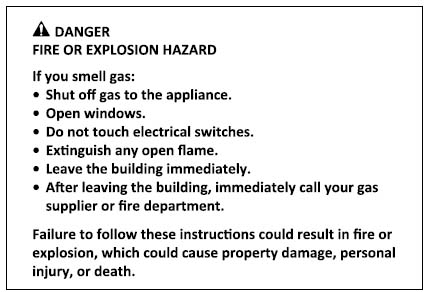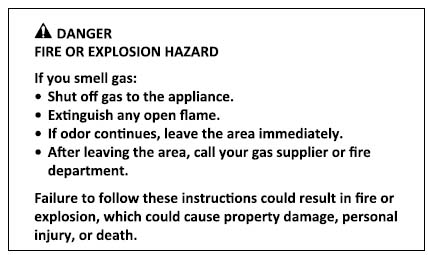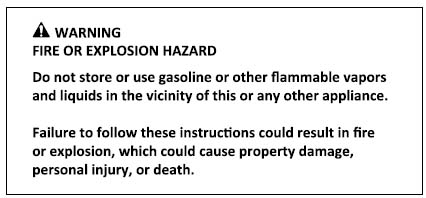ANSI Z21.42, Gas-fired illuminating appliances
Effective February 28, 2018
Effective Date: February 28, 2018
Impact Statement: A review of all Listing Reports is necessary to determine which products comply with new/revised requirements and which products will require re-evaluation. NOTE: Effective immediately, this revised standard will be exclusively used for evaluation of new products unless the Applicant requests in writing that current requirements be used along with their understanding that their listings will be withdrawn on Effective Date noted above, unless the product is found to comply with new/revised requirements.
Overview of Changes: New and revised requirements for: Components, Construction, Instructions, Markings, Performance, and Manufacturing and Production Tests. Specific details of new/revised requirements are found in table below.
If the applicable requirements noted in the table are not described in your report(s), these requirements will need to be confirmed as met and added to your report(s) such as markings, instructions, test results, etc. (as required).
Client Action Required:
Information – To assist our Engineer with review of your Listing Reports, please submit technical information in response to the new/revised paragraphs noted in the attached or explain why these new/revised requirements do not apply to your product (s).
Current Listings Not Active? – Please immediately identify any current Listing Reports or products that are no longer active and should be removed from our records. We will do this at no charge as long as Intertek is notified in writing prior to the review of your reports.
| Clause | Verdict | Comment |
|---|---|---|
| 3 | Info | added definition for automatic burner ignition system |
| 4.2.4 | A post, when supplied by the manufacturer for outdoor installation, shall have strength and rigidity at least equivalent to that of a 2 ½ in (63.5 mm) diameter post constructed of 0.064 in (1.63 mm) thick steel. | |
| 4.9 | Info | Gas ignition systems and components |
| 4.9.1 | Ignition shall be capable of being accomplished by a paper book match in accordance with the manufacturer's lighting instructions included in the instruction manual. A lighting rod supplied with the appliance for use with a paper book match is acceptable. | |
| 4.9.2 | Automatic gas ignition systems and components, when provided, shall comply with the applicable construction provisions of the Standard for Automatic Gas Ignition Systems and Components, ANSI Z21.20. | |
| 4.9.3 | If a piezo-electric spark device is used for ignition, it shall comply with the Standard for Manually-operated piezo-electric spark gas ignition systems and components, ANSI Z21.77 • CSA 6.23. | |
| 4.9.4 | If a manually-operated electric ignition system is used for ignition, it shall comply with the Standard for Manually-operated electric gas ignition systems and components, ANSI Z21.92 • CSA 6.29. | |
| 4.9.5 | Ignition shall occur within 4 seconds of gas being available at the burner. | |
| 4.10 | For appliances for indoor installation:   | |
| 4.11.1 | Class IIA-2. Permanent Plate Shall be made of metal having a thickness of 0.006 to 0.012 inch (0.152 to 0.305 mm) and shall have mechanical attachment means at all corners with a maximum spacing of 6 inches (152 mm) between mechanical fasteners. Class VI. Attached Tags Shall comply with Clause 5.16, Permanently attached marking tags. | |
| 5.5.1 | Burner flames shall not flash back (a) upon immediate ignition at normal test pressure; (b) two to five seconds delayed ignition at normal test pressure; (c) when the gas valve is adjusted to reduce the input rating to just below the point of visible illumination; or (d) during any other test in this standard. Tests shall be conducted with a cold start and then repeated after 15 minutes of continuous operation. Appliances equipped with a pilot burner and safety shut-off device assembly are exempt from item (b). | |
| 5.9.2 | The maximum temperature on the handle of a manual gas valve shall not exceed room temperature by more than 40°F (22°C) for metallic handles and 60°F (33°C) for non-metallic handles when determined in accordance with the following Method of test. Method of test The appliance shall be operated as prescribed in Clause 5.8, Wall and ceiling temperatures. After one hour of operation, handle temperatures shall be determined by exploring the handle surface with a 24 AWG (0.21 mm2) iron-constantan thermocouple. | |
| 5.9.3 | The temperature of the manual valve shall not exceed its rated value when tested as defined in Clause 5.8, Wall and ceiling temperatures. | |
| 5.10.2 | The temperature of the gas appliance pressure regulator shall not exceed its listed value when tested as defined in Clause 5.8, Wall and ceiling temperatures. | |
| 5.11.2 | The temperature of the automatic valve shall not exceed its listed value when tested as defined in Clause 5.8, Wall and ceiling temperatures. | |
| 5.12 | Gas ignition systems and components Automatic gas ignitions systems and components, when provided, shall comply with the applicable performance provisions of the Standard for Automatic Gas Ignition Systems and Components, ANSI Z21.20 • CSA 6.4. If a piezo-electric spark device is used for ignition, it shall comply with the Standard for Manually-operated piezo-electric spark gas ignition systems and components, ANSI Z21.77 • CSA 6.23. | |
| 5.14 | Glass Embrittlement The glass of a gas-fired lighting appliance shall not crack or break when subject to operation as in Clause 5.8, Wall and ceiling temperatures. | |
| 5.16 | Permanently attached marking tags | |
| 5.16.1 | Markings which are attached to the light with a flexible type fastener in accordance with Clause 4.11.1 shall not become detached from the light when tested as follows. Method of test A 25 lb (11 kg) weight shall be securely attached to the marking tag in such a way that it does not interfere with the attachment of the marking to the flexible type fastener. The light shall be securely supported above the floor a sufficient distance to allow the flexible type fastener, marking tag and attached weight to hang straight down without impact and without touching the floor for 60 seconds. The marking shall not become detached from the light. | |
| 5.16.2 | Markings which are attached to gas-carrying components with a flexible type fastener in accordance with Clause 4.11.1 shall not cause damage or leakage to any of the light's gas-carrying components when tested as follows. Method of test A 50 lb (23 kg) weight shall be securely attached to the marking tag in such a way that it does not interfere with the attachment of the marking to the flexible type fastener. The light shall be securely supported above the floor a sufficient distance to allow the flexible type fastener, marking tag and attached weight to hang straight down without impact and without touching the floor for 60 seconds. The marking may become detached from the light, but there should be no evidence of damage or leakage to any of the light's gas carrying components. | |
| 6 | Manufacturing and production tests The manufacturer shall submit to the certifying agency a plan which is mutually acceptable to the manufacturer and the certifying agency and which describes the programs and test procedures specified in Clauses 6.1, 6.2, and 6.3 and the records to be kept by the manufacturer. | |
| 6.1 | The manufacturer shall use a program to qualify raw materials, parts, assemblies and purchased components. | |
| 6.2 | The manufacturer shall conduct the following tests on each device at room temperature (as applicable): a) Test each burner and manifold and control assembly for proper burner and gas valve operation and verify the gas-tightness of the manifold and control assembly. This test shall be conducted on completely assembled appliances, when feasible. b) If appliances are not shipped assembled from the factory, the manufacturer shall periodically assemble an appliance from production to check the compatibility of the subassemblies. The appliance shall be capable of ready assembly. It is suggested that one appliance be so checked for each 100 appliances produced, but not less than one for each week's production. | |
| 6.3 | The manufacturer shall use a program which includes a mutually acceptable schedule(s) to conduct the following tests, as applicable: a) Clause 5.4, Combustion; and b) Clause 5.5, Burner operating characteristics. | |
| 6.4 | The manufacturer's test method(s) shall be capable of relating back to the test(s) specified in the standard. For ease of reference, clause numbers of tests in Clause 4 and Clause 5 of the standard are provided in parentheses. | |
CUSTOMERS PLEASE NOTE: This Table and column "Verdict" can be used in determining how your current or future production is or will be in compliance with new/revised requirements.